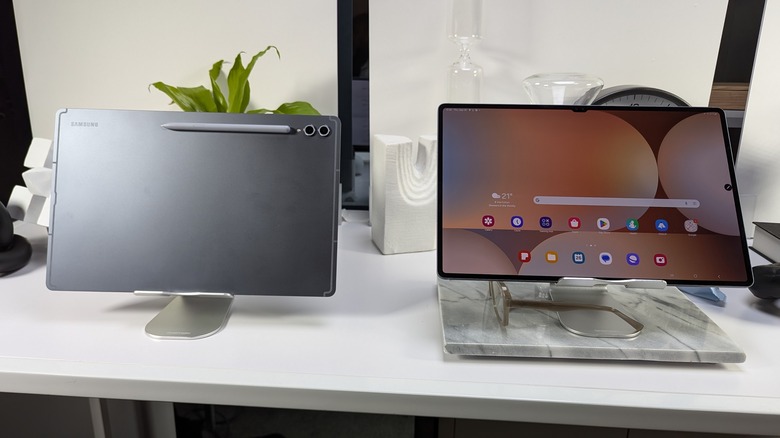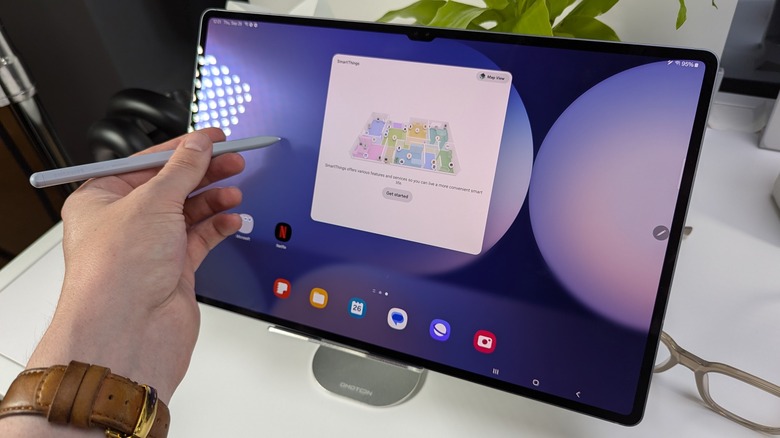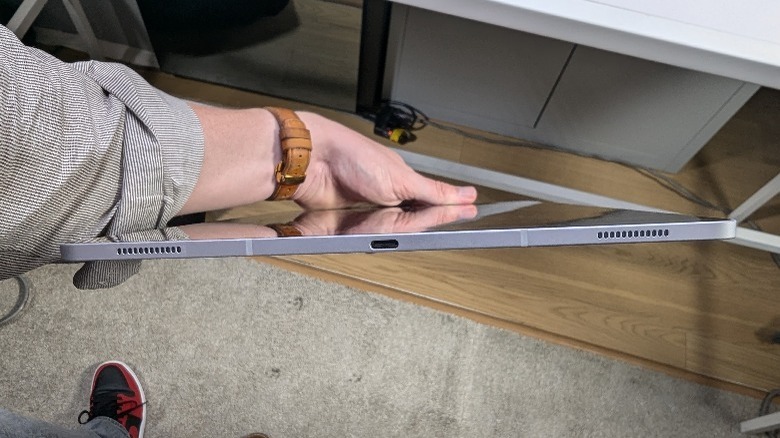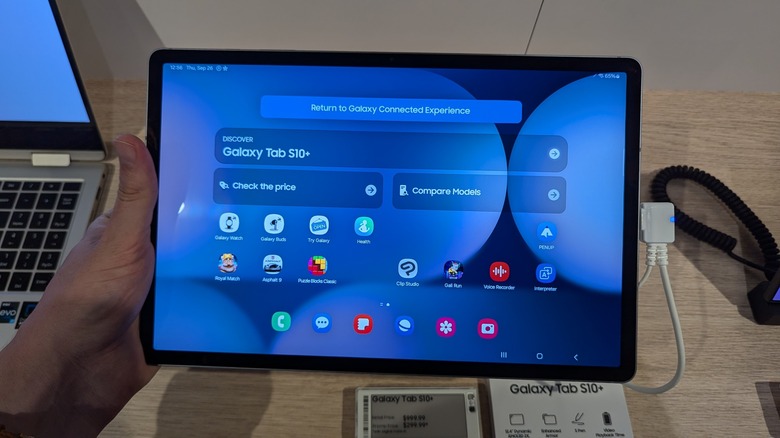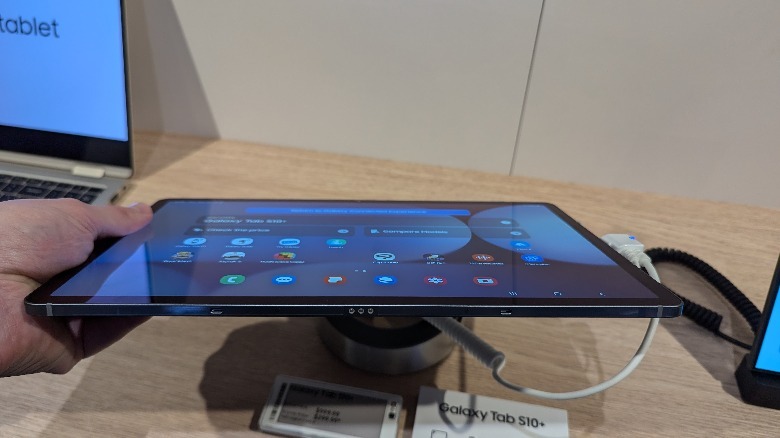Samsung Galaxy Tab S10+ And S10 Ultra Hands-On: What I Noticed Right Away
Samsung's biggest announcement on September 26 was arguably the addition of two new devices to its Galaxy Tab lineup. The Galaxy Tab S10+ and S10 Ultra are set to define the high-end of Samsung's tablet offerings; they have a premium price point, premium finish, and promise to make the most of Samsung's ever-growing suite of AI tools. Those AI features were a main focus of Samsung's announcements, as they have been with most of the company's releases over the past year. On the tablets you can expect help with handwriting, math problems, photos, and more. It can translate PDFs, allow you to search with gestures, and doctor pictures with little more than a scribble. The Korean tech company also announced an FE version of the S24, and a version of the Watch FE with LTE capabilities.
In terms of the tablets' hardware, there's a lot to like about both new models, not the least of which is the impressive anti-reflective Dynamic AMOLED 2X displays you'll notice immediately upon looking at the devices. There's also a quad speaker system and, much like Samsung's TVs, the onboard AI can isolate dialogue during a TV show or movie, making it easier to hear — all signs pointing toward these being excellent media consumption devices. Following the company's announcement, I was able to get some hands-on time with both the S10+ and the S10 Ultra.
The Galaxy Tab S10 series packs huge displays
Though my time with the new Galaxy Tab S10+ and S10 Ultra was limited, it was long enough to make a solid impression. The first thing that stands out is the screen: the S10+ with its 12.4-inch 2800 x 1752 resolution display seems fairly average upon first glance, but the size of the S10 Ultra — with its huge 14.6-inch 2960 x 1848 resolution screen — definitely catches the eye. Some Tab S10+ specs are still pending, but Samsung has detailed the hardware loadout for the Ultra model, and it includes everything from a quad-speaker system to a 120 Hz refresh rate, IP68 durability rating, and MediaTek Dimensity 9300+ under the hood.
As far as the display goes, there's the aforementioned anti-glare display coating, and although this is an extreme example, it's worth noting that it was not enough to fend off a direct blast from the bright lights Samsung had surrounding the device (as seen in our image above). Despite that, the screen was still readable and the lights didn't manage to glare across its entire surface. When it comes to how it will perform outdoors, direct sunlight is probably going to dampen the experience, but I'm guessing you'll still be able to see it clearly on a bright day. Samsung says as much, claiming its display tech facilitates a "vibrant yet natural viewing experience" when outside.
Both tablets have a premium, durable finish
As you handle the tablet, you'll notice a lot about its level of finish. With the Ultra, it's every bit as premium as you would expect from one of Samsung's flagship devices — and the same applies to the smaller, slightly cheaper S10+. Everything is perfectly machined, there are no suggestions of any quality control oversights. Among other things, Samsung utilized what it calls enhanced Armor Aluminum as part of the S10 series' construction, noting that it is intended to help protect the tablets from "bumps and scrapes." Both versions of the tablet are easy on the eye and comfortable in your hand. The included pen is also feather-light and feels comfortable when you're swiping and scribbling.
In terms of size, the S10 Ultra and S10+ are almost ridiculously thin — they measure in with a thickness of 5.6 mm and 5.4 mm, respectively. Despite that, there is some noticeable heft, with the Tab S10+ weighing in at 576 grams and the S10 Ultra at 723 grams for the 5G version (the Wi-Fi-only variants are ever so slightly lighter). For comparison, the cellular version of the 13-inch iPad Pro M4 we reviewed earlier this year clocks in at 582 grams — but, of course, Samsung's Ultra display is considerably larger, contributing to the added weight.
High prices and a lot to live up to
The tablets seem to run smoothly, though I didn't get the chance to test anything particularly demanding on them — and the included Dimensity hardware does raise some questions over just how much multitasking these devices can handle. In my limited time with the devices, I was only able to load the basic apps Samsung had installed and transition between menus. Unsurprisingly, the $1,000+ devices have responsive, comfortable touchscreens and were able to instantly load those basic apps.
Although cameras on tablets tend to be poor and should be for emergency use only — Samsung's efforts looked pretty good when fired up. It should be noted that the cameras were looking at objects in pretty much ideal settings, as the lighting was very good. The camera hardware on both models is nearly identical with dual 13 MP and 8 MP ultra-wide cameras on the back and an ultra-wide 12 MP camera on the front; the only exception is the addition of a second 12 MP camera on the front of the Ultra model. We can't say at this point how well the cameras would perform at night, but that's where some of the much-touted AI features could give it an edge.
Overall, this hands-on session was a very mild taster, and it will be interesting to see how the tablets hold up to a full in-depth review. Given the price points — $999 and $1,199.99, respectively — it's fair to expect a lot from Samsung's new flagship tablet and its little brother. With sector-leading prices you should see sector-leading performance. First impressions are good, but there's definitely a whole lot more to see.
